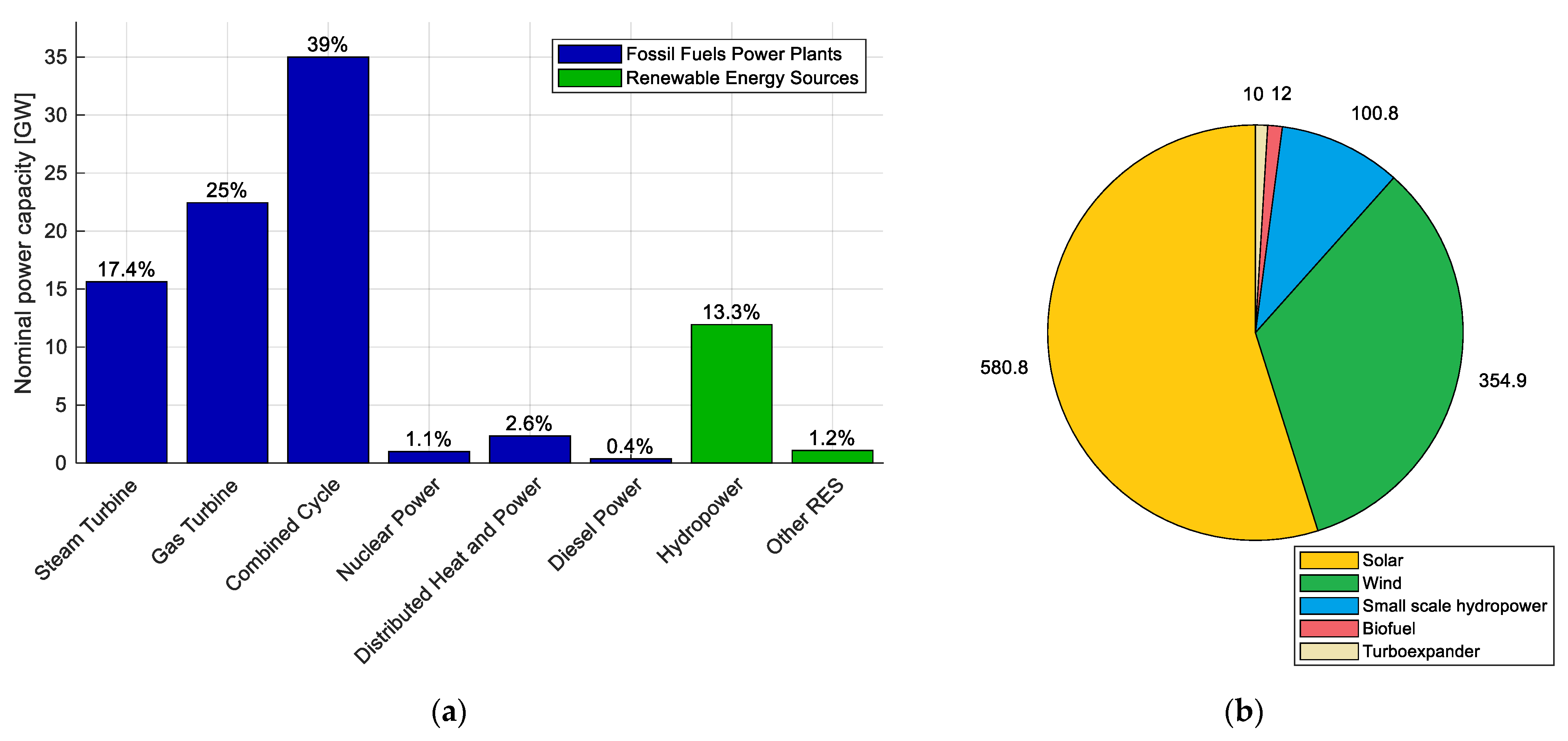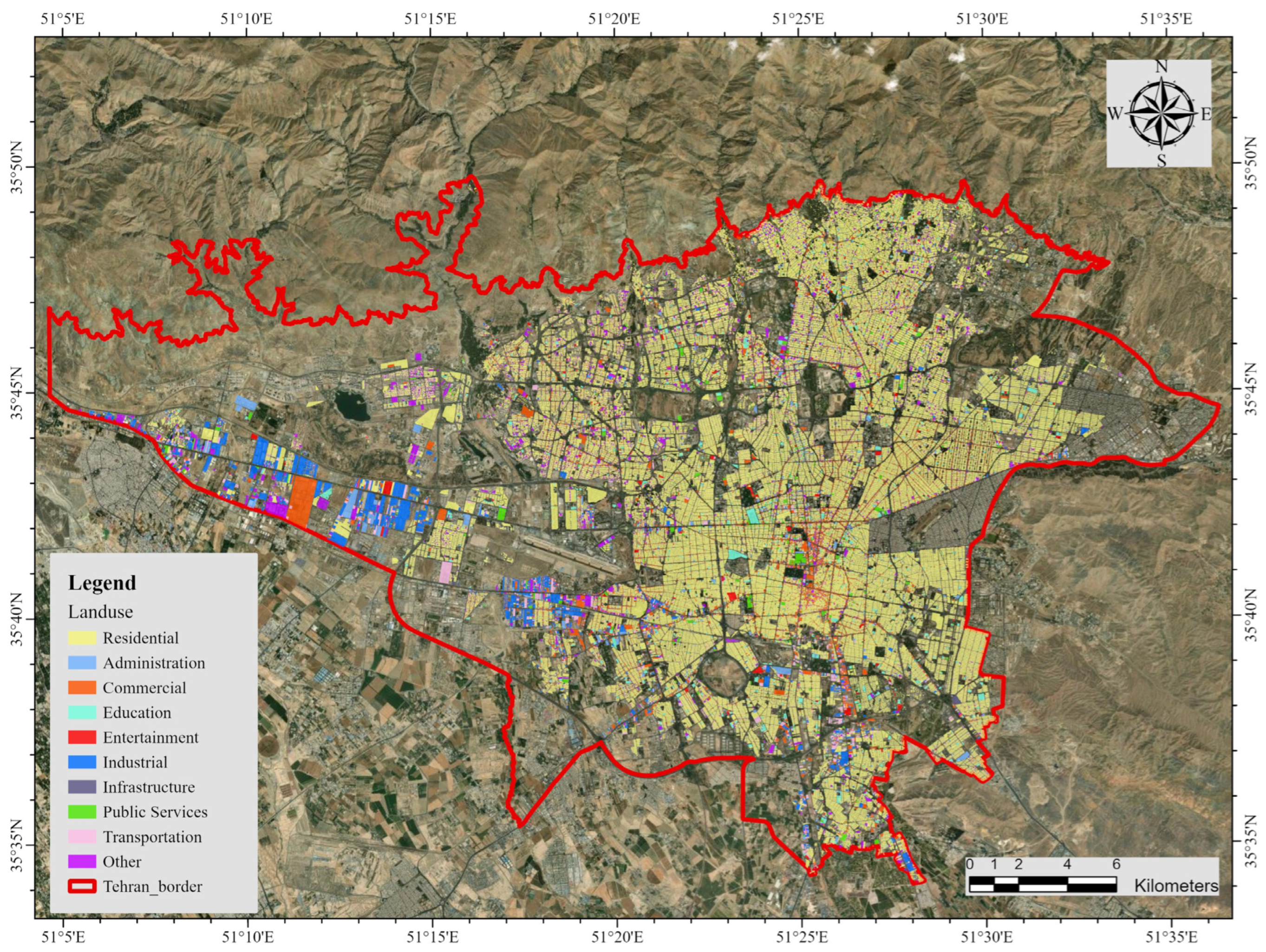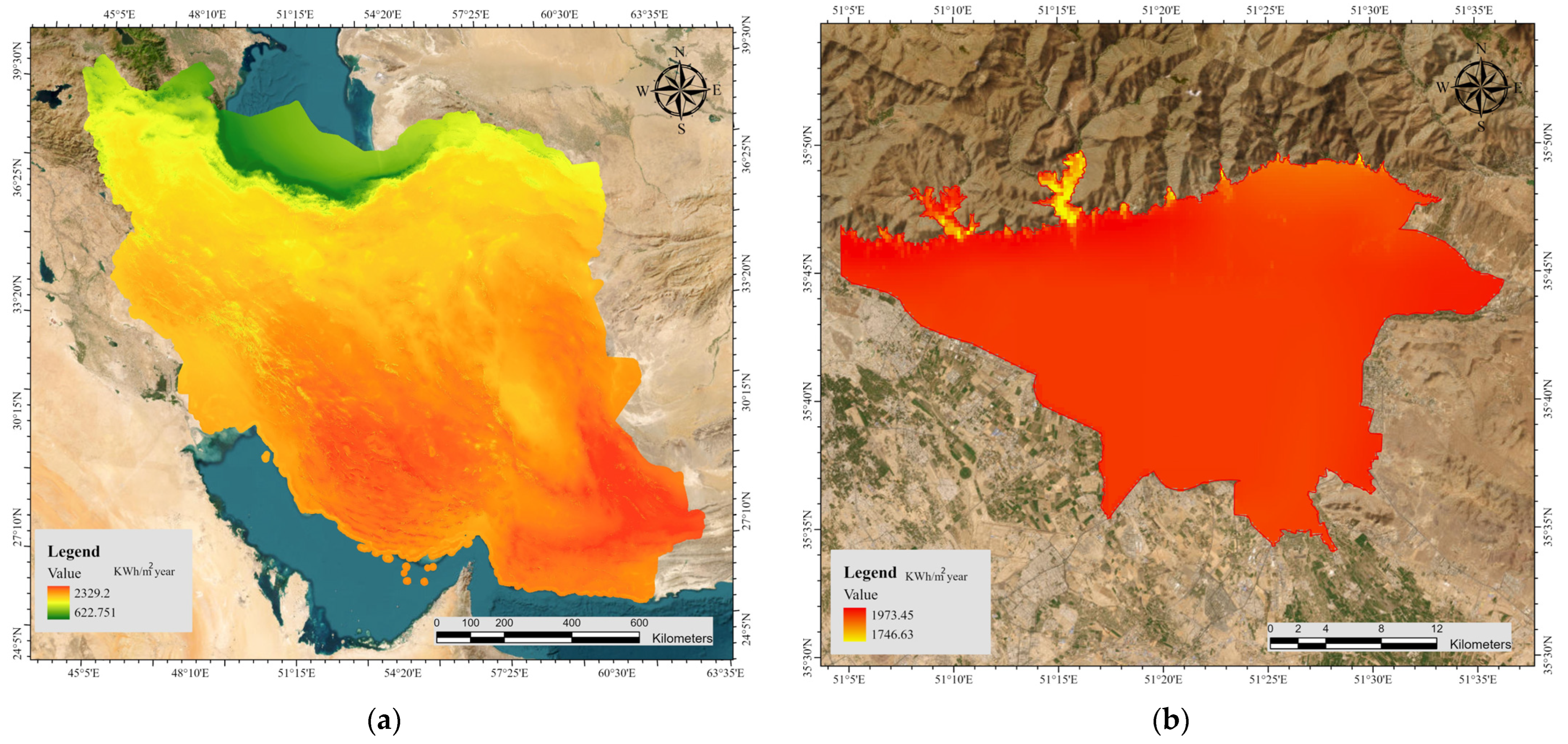1. Introduction
The rapid growth of global energy consumption and the escalating concerns over climate change have intensified the quest for sustainable and renewable energy sources. Iran, as a nation characterized by substantial energy consumption and production, faces increasing challenges arising from its heavy reliance on fossil fuels. The country is among the highest CO
2-emitting nations in the world, with electricity production causing nearly one-third of the pollution [
1]. The persistent use of non-renewable energy sources not only results in environmental degradation, but also poses economic and social implications. Tehran has been dealing with severe air pollution in recent decades and is one of the most polluted cities in the world [
2,
3]. The cost of health issues caused by air pollution is estimated to be approximately 5% of the total GDP of the city [
4].
In spite of recent regulations and initiatives for renewable energy establishment, still, more than 85% of the electricity production relies on fossil fuel-based power plants (FFPP) [
5]. The situation is even worse in Tehran, where FFPP accounts for nearly 96% of the electricity production, based on a report from Iran’s power generation, transmission and distribution management company (TAVANIR) in 2020.
Figure 1a shows the distribution of electric power plants in Iran based on the latest report from TAVANIR published 18 June 2023. The notable point is that renewable energy resources (RES) contribute only 1.2% of the 91,000 MW nominal power capacity of the whole country.
Figure 1b depicts the distribution of these RES plants.
Based on the latest reports from TAVANIR, during the hottest days of July 2023, a new historical maximum consumption record above 70,000 MW was recorded for the country. This puts a lot of pressure on the power production network of Iran, resulting in power outages. To prevent blackouts and cope with the supply–demand gap in the summer of 2022, the government was forced to limit the power usage of electricity-intensive industries and office hours [
6].
Considering the increase in power demand and environmental problems, the need to adopt clean and sustainable energy solutions is becoming paramount. Among these, solar photovoltaic (PV) systems have emerged as a promising solution, offering clean, abundant, and inexhaustible energy from the sun [
7]. Rooftop solar PV installations, in particular, present a compelling opportunity to harness solar energy within urban environments, optimizing space utilization within cities, preventing conflicts with other sectors such as food production, reducing dependence on traditional fossil fuels and eventually moving towards green net-zero-energy buildings [
8]. The incorporation of intelligent systems within renewable energy production can further increase the efficiency in the power generation sector [
9].
Iran, a country endowed with abundant solar irradiance and an expanding urban landscape, is positioned to exploit the enormous potential of rooftop solar PV technology [
10]. The capital city, Tehran, as the core of Iran’s economic and cultural activities, has experienced unprecedented urban development over the years, resulting in an increased demand for electricity [
11]. To address this growing energy demand sustainably, there is an urgent need to assess the rooftop solar PV power production potential across the metropolitan area.
This paper endeavors to explore the untapped potential of solar energy, particularly through rooftop photovoltaic (PV) installations, in the Tehran metropolitan area. It presents a comprehensive study focusing on a large-scale rooftop solar PV power production potential assessment for the Tehran metropolitan area. By quantifying the capacity for solar energy generation in this urban setting, the study seeks to provide valuable insights for policymakers, urban planners, and energy stakeholders and thus facilitate informed decision-making towards the integration of renewable energy solutions into the existing energy infrastructure, moving towards cleaner energy production and decreasing its carbon footprint. Furthermore, the findings will facilitate the formulation of effective strategies for integrating renewable energy into the current energy system, thus accelerating Iran’s sustainable development goals and its commitment to combat climate change.
The remainder of the paper proceeds as follows:
Section 2 presents a detailed literature review of different methods and various aspects of rooftop PV potential assessment.
Section 3 discusses the study area, data used and the methodology employed. Then,
Section 4 provides the results obtained within this research. Discussion of the results of the study, as well as its limitations and potential future research areas, are presented in
Section 5. Finally,
Section 6 concludes the work by providing final remarks.
2. Literature Review
The interest in studying rooftop-mounted solar PV power potential assessment has risen worldwide in recent years. Based on the literature, the most important steps when addressing rooftop PV potential are, first, to accurately estimate the available rooftop area to be used for installing PV modules. In this regard, Geospatial Information System (GIS) in combination with various methods such as sampling, geostatistical, modeling and machine learning (ML) methods, together with satellite imagery, LiDAR and digital surface models (DSMs), has been used to calculate the available roof area [
12]. Then, the amount of solar irradiation in the available area must be determined. There are various ways to estimate received solar power in a region, including physical, empirical and semi-empirical models that basically use satellite data to acquire the main meteorological parameters for modeling purposes [
13]. The last aspect of these estimations is the technical part, concerning the PV technologies available, along with different design approaches and their performance and loss rates. Here, we present a brief literature review of the state-of-the-art research on this subject, focusing on the aforementioned aspects, along with studies on this subject for Iran. For a more detailed review of works conducted, readers can refer to the following articles [
12,
14,
15].
Estimating the available roof area to be exploited for PV panel establishment is the primary step in rooftop PV potential assessment. Izquierdo et al. developed a method to estimate the available roof area using land use and population density data to compute the rooftop solar energy potential of cities of Spain [
16]. They reported an available roof area of 14 ± 4.5 m
2 per capita in Spain to install PV modules. In another study on Andalusia in Spain, Ordóñez et al. [
17] developed a statistical method to calculate available roof area based on the number and typology of buildings. Moreover, they considered different design scenarios and evaluated their respective power outputs. They found that there is a 9.73 GW per year potential in the rooftops of the residential buildings in the study area. Singh and Banerjee [
18] proposed a method to estimate building footprint areas from land use data, which they later used to estimate the available roof area for PV installation. For obtaining the solar irradiation, they used data from a reference book and the Liu Jordan physical model to compute the plane-of-array (POA) solar irradiance. They also performed simulations using the PVSyst software to acquire appropriate ratio values for estimating available roof area and solar irradiance in the study area of Mumbai, India. They computed the potential power production as 2190 MW, which could provide more than 14% of the consumption of city. Furthermore, they evaluated the potential output power of various types of PV modules.
Satellite imagery and DL methods have shown promising results in terms of accurate available roof area [
19]. Jo and Otanicar employed object-based image analysis (OBIA) on high-resolution satellite imagery to omit rooftop objects from the final roof area and calculate their shadowing effect [
20]. The results show that the proposed method of roof area detection for the PV installation had a 4.21% error rate. In another study, Zhong et al. [
21] proposed an approach to extract the roof area from satellite imagery using deep learning (DL) with 92% accuracy. They considered the rooftop as a horizontal plane, and thus used global horizontal irradiance (GHI) to determine potential solar irradiation and computed the yearly solar power output to be 311,853 GWh for the city of Nanjing, China. Jiang et al. [
22] took advantage of DL methods for both estimating roof area available from satellite images and solar irradiance from geostationary satellites.
One of the most determinative parameters affecting the PV panels’ performance is shadowing, which can have several sources, such as adjacent panels, roof features, and surrounding building and trees. GIS has been beneficial in this regard, employing spatial analyses for computing shadowed areas based on 3D building data. Hong et al. developed a method to analyze the effects of building shadowing on the available roof top area through hillshade spatial analysis [
23]. They acquired the footprint area of buildings along with the number of floors to calculate the shadowed area, and exclude it from the overall roof area. They estimated the available roof area of the Gangnam district in Seoul to be 4.96 km
2, with a potential 1130 GWh annual solar power production. Pinna and Massidda, in their study [
24], used DSM data to consider rooftop orientation and slope in their estimation of rooftop solar power potential for Cagliari, Italy. They also developed an algorithm for computing the shading effect using the DSM model, which they have published in open source format on GitHub. Rodríguez et al. [
25] used 3D CityGML models to extract roof area based on geometric building models through the SimStadt software developed by the university of Stuttgart. In an extensive study, Walch et al. [
26] evaluated the rooftop PV potential of Switzerland through a comprehensive method combining ML, GIS and physical solar irradiance models. They developed 3D CityGML models of a building to derive its roof geometry products, such as slope, orientation and available area, to run simulations on different PV panel design. They also used the DSM model together with ML methods to quantify shading effects. Moreover, they employed physical models and meteorological data to compute solar irradiance, and then used ML to extrapolate their calculation for the entire area. They applied their methodology to 9.6 million rooftops throughout Switzerland, and the results revealed that 55% of the total roof area is available for PV installations, which could produce an annual power of 24 ± 9 TWh, equivalent to 40% of the country’s electricity demand.
A small portion of research has focused on the different PV modules’ performances under various ecological and geographical circumstances. For example, Huld and Amillo [
27] studied the performance of two module types in a large-scale area of Africa–Europe–Asia in relation to multiple factors, including module reflectivity, solar spectral variations, air temperature and wind. They found that the most noticeable effect is on temperature and irradiance.
Finally, there are studies that focus on the financial potential, and combined it with previous levels of assessments to evaluate the degree to which this potential is feasibly exploitable. Furthermore, they provide results that can be of utmost importance for decision-makers and authorities. Gautam et al. [
28] studied the energy usage and electricity consumption situation in Nepal, and assessed the potential power output and economic feasibility of deploying PV panels on rooftops. Mainzer et al. [
29], after computing the potential rooftop solar power for each municipality in Germany, evaluated the outcome relative to the electric loads of municipalities to propose policies for maximizing the solar power, and also assessed the technical potential under different scenarios. In a global-scale big data study, Joshi et al. [
30] studied the potential rooftop PV, combining the bottom-up and top-down approaches using a fishnet DL method. They estimated the global potential to be 27 TWh/year out of 0.2 million km
2 available rooftop area.
Regarding the research study area, much of the work mainly concentrates on the overall potential of the country to adopt a solar PV system, and demonstrates this potential through economic evaluation [
31,
32,
33]. In [
34], using a multi-criteria decision-making method, the authors have shown possible hurdles in the way of PV adoption in Iran. They found that the most prominent negative features are the disordered economic state and the cumbersome nature of paperwork and bureaucracy. The recommended solutions were identified as financial incentives. In another study, a fuzzy logic decision-making method was employed to determine which provinces of Iran are most capable of adopting PV power plants using social, technical, economic and environmental criteria [
35]. There is also some research that has used GIS methods to assess PV solar energy usage in Iran [
36,
37,
38].
According to the existing literature, a notable gap exists in the assessment of the rooftop solar power potential within Iran, despite its geographical location that should dispose it to taking advantage of this clean and abundant energy. Regarding the country, much of the previous research has aimed at detecting the most suitable site the construction of large-scale PV power plants, rather than rooftop-integrated PV installations. Therefore, this research intends to cover this gap and quantitatively explore the potential of urban rooftops to produce electricity from solar energy. It endeavors to provide a much more realistic value of the potential power generation in order to improve awareness among policymakers and decision-makers in the move towards clean solar energy.
5. Discussion
The present study has attempted to estimate the potential power output of rooftop solar PV installations in Tehran, the capital of Iran. The methodology proposed is based on a multi-level framework within the GIS environment. Of the 214 km2 parcel area, 11.67 km2 is estimated as the roof area exploitable for PV panel installation, which represents 5.45% of the total parcel area. Based on the solar irradiation data, the power production for a year is calculated to be 3225 GWh. Considering the TAVANIR report, this amount corresponds to approximately 14% of the electricity consumption of Tehran in the year 1400 (national calendar system, 21 March 2021–20 March 2022)—23,450 GWh. On the other hand, the capacity potential is computed to be 2151 MW, which is nearly one-third of the July 2023 peak in the Tehran power distribution network. Moreover, this number is roughly four times the current PV capacity of the whole country (580.7 MW).
This work would benefit from several adaptations that would enable it to achieve a more accurate result. The main inputs of this assessment were roof area and solar radiation. If these were to be acquired in a more precise manner, the results would reflect a finer estimation. Therefore, a way to improve the current research could involve the acquisition and usage of more finely detailed building information to obtain the exact roof area and its geometry. Also, 3D data can be very useful in this regard when computing the shadow effects of buildings. Furthermore, the employment of a combination of physical–empirical methods for modeling the sun, its trajectory, its orientation, its azimuth, and other parameters in the area relevant to calculating different components of solar irradiance can yield an outcome more reflective of the real-world situation for potential solar power evaluation. Moreover, considering the financial aspects of such developments, including the PV panels’ efficiency through time and the requirements of other necessary equipment, could lead to a more realistic assessment, and help us determine the financial feasibility of using PVs in the more effective management of a renewable energy infrastructure.












